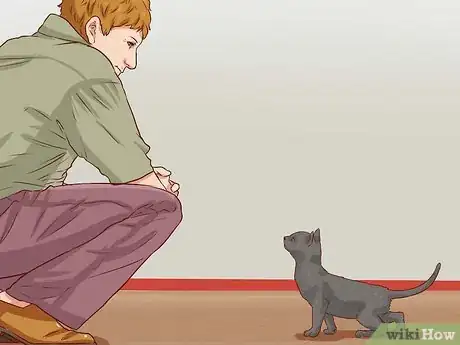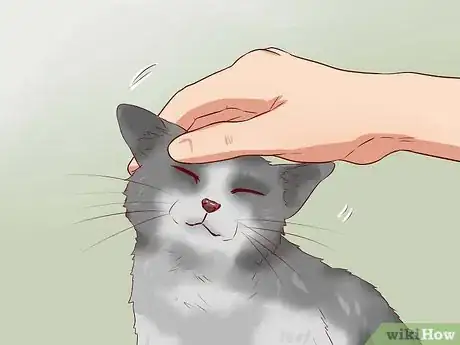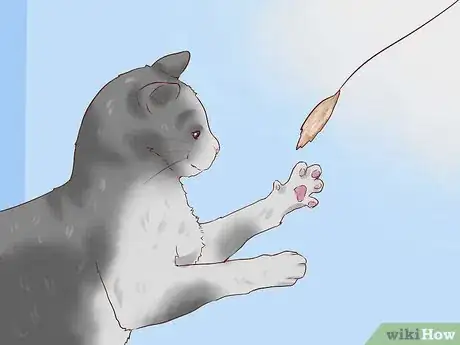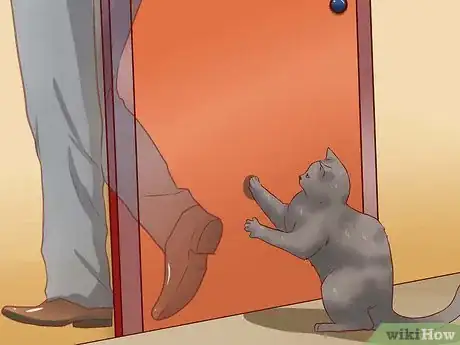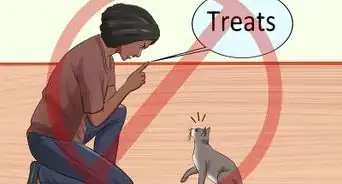This article was co-authored by Jessica Char. Jessica Char is a Cat and Dog Trainer, Behavior Consultant, and the Founder of Feline Engineering and Canine Engineering. She specializes in modifying challenging pet behavior problems, such as fear and aggression, using positive reinforcement training protocols. Jessica is a Certified Fear Free Trainer, a Certified Professional Dog Trainer, and a Certified Separation Anxiety Trainer. She is also a member of the International Association of Animal Behavior Consultants. Jessica received her BS and MS in Biomedical Engineering from Washington University in St. Louis.
wikiHow marks an article as reader-approved once it receives enough positive feedback. This article has 14 testimonials from our readers, earning it our reader-approved status.
This article has been viewed 564,753 times.
When you love your cat, it can be hard to discipline him. Even when he is being bad, he can be so cute and cuddly that you don’t want to yell at him or tell him he is doing wrong. There may be other times when your cat can drive you crazy, but any attempt at disciplining him falls flat. You may even ask yourself, “do I own my cat, or does my cat own me?" You can teach your cat how to behave with better manners if you learn the right methods.
Steps
Getting Ready to Discipline Your Cat
-
1Recognize the complications. Cats can be easy or difficult to train. Dogs are more eager to please their owners, which makes them generally easier to train than cats. However, cats can be trained as long as you understand how cats think and interact with their humans. Training a cat takes a lot of patience, especially since it is so hard to motivate him.[1]
-
2Find your cat’s motivator. Every cat has something that will make him learn to listen to you. This key to training is called your cat’s motivator. This generally means the tastiest treat that he absolutely loves and goes crazy over. For some cats, this can be flakes of tuna while for others, a tiny taste of cooked chicken will do the trick.Advertisement
-
3Love your cat. The first step to disciplining your cat is first to make him listen to you. This won’t happen unless you develop a warm, loving relationship with your cat. This cannot be stressed enough. It's important to set up a good rapport with your cat from the beginning of your relationship. This will ensure that he respects you, will want to please you, and will listen to your commands.
- If you are just acquiring a cat, give him lots of attention. Spend time cuddling with him if he responds to that. If not, try to talk to him and pet him as much as you can, and give him treats once in a while. This may take a few days to a few weeks, depending on how long he takes to warm up to you and his new environment.
-
4Take your time with a kitten. Although it's important to discipline your cat as soon as any bad behavior starts, take the time to consider who you're dealing with. There are some cat specific factors that may affect how your pet reacts to your attempts at discipline. If you have a kitten, you should expect him to be very rambunctious, curious, and inexperienced. It may take longer for a kitten to learn right and wrong, so be patient as he figures it out.
- On the other hand, having a kitten can be a benefit. If you're the only owner the kitty has ever had, then you can exert more influence over his actions.[5]
-
5Deal with older cats. If you are just getting a new cat who is older, if you adopt an older cat, or if the cat you have had for a while and need to discipline is older, remember that an older cat may be set in his ways. He may be used to a certain form of discipline and you'll have to work harder to show the cat what is wrong and right.
- However, older cats can be more mellow, understanding, and may not be as eager to misbehave.[6]
-
6Consider your pet’s prior experience. Before you discipline your cat, think about what kind of life your cat had before you got him. If your cat or kitten is coming from a breeder and is used to good treatment, being groomed, and being well-fed, then your cat should not act out from past trauma. If the cat was taken out of an abusive home or spent a long time in the pound, you may have to work a bit harder with your cat.
- Remember that adopted or abused cats may be scared and suspicious of new environments and you, depending on his past experiences with other owners.[7]
-
7Pay attention to your cat's personality. The personalities of cats can be just as diverse and complicated as the personalities of their owners. Ask yourself a few questions to understand your cat's personality. What kind of a cat do you have? Would you describe him as squirrelly, eager-to-please, lazy, or loving? Your cat's unique personality can help you decide how to react in certain circumstances.
- Easily scared or frightened cats will take a more delicate touch when disciplining. You will need to first work on gaining his trust before attempting discipline.
- An aggressive cat will need to be evaluated by an animal behaviorist so you don’t get hurt when attempting to discipline the cat.
Training Your Cat
-
1Provide outlets for his needs. To keep a cat from getting into trouble, provide your cat with means and ways to express his natural cat behavior. Cats love to run, bite, scratch, and explore by nature, so it's important to give your cat friendly options to play with so he has an outlet for his needs. This can also prevent many disciplinary issues that will arise because he will be more content overall.[8] There are many ways you can help your cat express his inner feline needs.
- Provide a scratching post for your cat. Make sure to have one or multiple scratching posts around the house so your cat can scratch those. This will prevent him from scratching your furniture, the walls, or other objects he shouldn't.
- Have toys for your cat to chew and bite. Chew toys, little balls, and stuffed mice can help your cat use his inner instincts without biting or harming you in the process. This can also deter him from eating other objects that you don't want him to chew on.
- Create a kitty space or playground in your house that he can use all day long. Cats love to jump, climb, and explore, so get a cat jungle gym or establish a corner of your house that is cat friendly so he can run around without ruining your property.
-
2Reward good behavior. It's important to let your cat know when he does something good. This will help him learn that this behavior should be repeated. Good behaviors can range from using the litter box properly, eating and drinking his food appropriately, using his scratching post instead of the furniture, and playing with his toys instead of your belongings. It's also important to be consistent. Reward your kitty for positive behavior as often as you can so he knows he's on the right track. Treats are common ways to reward your cat.[9] Don't overdo it, however, because it can cause your cat to gain weight.
- You can also reward your cat by giving him attention. Speaking to your cat in a soothing voice, petting him, or letting him cuddle with you can help let him know that you appreciate what he's doing.
-
3Play with your cat. A way to help your cat act appropriately and also as a way to reward him is to play with him. When both of you are around the house, bring out an interactive cat toy that he needs you to play with. For example, many cats love dangling toys, such as sticks with feathers or shiny objects at the bottom. Take some time to play with the dangling toy whenever you can. Your cat will get some great exercise and will feel loved.
- An option for the lazier owner is the laser pointer. Some cats go absolutely crazy for the laser pointer and you can move it all over one room from the comforts of your own couch. Some people protest that the laser pointer is cruel because the cat never gets to catch the red dot, while others would argue that it's more about the chase.
Disciplining Your Cat
-
1Redirect and reinforce good behavior. There are times when your cat will behave in a way that needs disciplining. When this happens, try to refocus their attention on something that they're allowed to do instead. Once they turn their attention to that, praise them for their good behavior.[10]
- If your cat jumps on the counter, for example, redirect his attention to a toy on the ground. Once he jumps down and starts playing, give him extra attention and love to show that he did the right thing.
-
2Remove your cat from the situation. There are two ways that you can remove your cat from a situation where he is misbehaving. You can isolate your kitty.[11] If your cat is prone to eating your dinner, for example, you can exile him to your bedroom during dinner time. Though his meowing by the door may break your heart, it'll teach him not to repeat his mistakes.
- You can also remove him from the room after grabbing scruff of his neck. If your cat is being feisty with you and biting or scratching, you can grab him by the scruff of the neck and say “no.” If he keeps being bad, pick him up and take him to a different room, still saying no.
- Never pick a cat up by the scruff. It may hurt your cat and he may be able to hurt you by scratching you. Be aware that cat bites can quickly turn into a dangerous infection.[12]
- Putting your cat in a separate room gives him the chance to cool off.[13]
- An herbal plugin can also help your cat calm down.[14]
-
3Set booby-traps. You can set traps for your cat to prevent him from indulging in bad behavior. For example, if your cat is prone to attacking your toilet paper roll, place an empty water bottle on top of the roll, so it will fall if he tries to play with the roll. If your cat is prone to jumping on the kitchen table, set up double-sided tape or tinfoil over the surface, so he associates it with an unpleasant sensation. These physical barriers may give him the discipline he needs.[15]
- Avoid setting traps that may scare or harm your cat. Things like scat mats can really scare your cat. You want them to be disciplined, not afraid.[16]
-
4Be consistent. No matter what punishment you give your cat, it's important to discipline your cat consistently so that he knows you're serious about his bad behavior.[17] Each time the cat does something that is not acceptable, quickly react so he associates the bad behavior with the punishment. If you leave the punishment for later, he won't know why he is getting punished and may become afraid of you.
Expert Q&A
-
QuestionHowe can I make my cat feel loved?
 Pippa Elliott, MRCVSDr. Elliott, BVMS, MRCVS is a veterinarian with over 30 years of experience in veterinary surgery and companion animal practice. She graduated from the University of Glasgow in 1987 with a degree in veterinary medicine and surgery. She has worked at the same animal clinic in her hometown for over 20 years.
Pippa Elliott, MRCVSDr. Elliott, BVMS, MRCVS is a veterinarian with over 30 years of experience in veterinary surgery and companion animal practice. She graduated from the University of Glasgow in 1987 with a degree in veterinary medicine and surgery. She has worked at the same animal clinic in her hometown for over 20 years.
Veterinarian In addition to cuddling and petting, showing you love your cat also means meeting all their basic feline needs. As well as food and shelter, this includes playtime, the ability to climb, an opportunity to exercise their claws (scratch!) and hunt (even if it's toys). Meeting these needs leads to better behavior.
In addition to cuddling and petting, showing you love your cat also means meeting all their basic feline needs. As well as food and shelter, this includes playtime, the ability to climb, an opportunity to exercise their claws (scratch!) and hunt (even if it's toys). Meeting these needs leads to better behavior. -
QuestionWhat should I do when my cat poops on my bed after I'm gone for more than a full day?
 Pippa Elliott, MRCVSDr. Elliott, BVMS, MRCVS is a veterinarian with over 30 years of experience in veterinary surgery and companion animal practice. She graduated from the University of Glasgow in 1987 with a degree in veterinary medicine and surgery. She has worked at the same animal clinic in her hometown for over 20 years.
Pippa Elliott, MRCVSDr. Elliott, BVMS, MRCVS is a veterinarian with over 30 years of experience in veterinary surgery and companion animal practice. She graduated from the University of Glasgow in 1987 with a degree in veterinary medicine and surgery. She has worked at the same animal clinic in her hometown for over 20 years.
Veterinarian Cats often poop on items or places that smell strongly of something they link to security. In this case, she may be pooping on your bed because it helps her feel close to you and reassured when you are away. To resolve the problem, make sure she has a clean litter tray at all times, and put something that smells of you (a T-shirt or jumper) on her favorite sleeping spot. Also try using a feline pheromone diffuser which sends out reassuring signals. Do not punish her, as this only increases feelings of insecurity.
Cats often poop on items or places that smell strongly of something they link to security. In this case, she may be pooping on your bed because it helps her feel close to you and reassured when you are away. To resolve the problem, make sure she has a clean litter tray at all times, and put something that smells of you (a T-shirt or jumper) on her favorite sleeping spot. Also try using a feline pheromone diffuser which sends out reassuring signals. Do not punish her, as this only increases feelings of insecurity. -
QuestionI have four cats that are marking all over my house. What can I do?
 Pippa Elliott, MRCVSDr. Elliott, BVMS, MRCVS is a veterinarian with over 30 years of experience in veterinary surgery and companion animal practice. She graduated from the University of Glasgow in 1987 with a degree in veterinary medicine and surgery. She has worked at the same animal clinic in her hometown for over 20 years.
Pippa Elliott, MRCVSDr. Elliott, BVMS, MRCVS is a veterinarian with over 30 years of experience in veterinary surgery and companion animal practice. She graduated from the University of Glasgow in 1987 with a degree in veterinary medicine and surgery. She has worked at the same animal clinic in her hometown for over 20 years.
Veterinarian This requires considerable dedication and patience. Provide 5 litter trays (one for each cat plus one spare) in different locations around the house. Thoroughly deodorize all areas where the cats have already marked, as the scent will draw them back. Put food bowls on the areas where they toilet most often, as the cat is less likely to soil near food. Never punish a cat, as this increases their anxiety and the need to spray to establish her territory. Consider using Feliway to make the cats more tolerant of each other. Give each cat individual attention and play at some point during the day. Try and give the cats access to the outdoors.
This requires considerable dedication and patience. Provide 5 litter trays (one for each cat plus one spare) in different locations around the house. Thoroughly deodorize all areas where the cats have already marked, as the scent will draw them back. Put food bowls on the areas where they toilet most often, as the cat is less likely to soil near food. Never punish a cat, as this increases their anxiety and the need to spray to establish her territory. Consider using Feliway to make the cats more tolerant of each other. Give each cat individual attention and play at some point during the day. Try and give the cats access to the outdoors.
References
- ↑ https://www.aspca.org/pet-care/virtual-pet-behaviorist/cat-behavior/training-your-cat
- ↑ Jessica Char. Cat & Dog Behaviorist.
- ↑ https://www.aspca.org/pet-care/virtual-pet-behaviorist/cat-behavior/training-your-cat
- ↑ Rita Reimers. Cat Behaviorist. Expert Interview. 22 June 2021.
- ↑ Canine and Feline Behavior for Veterinary Technicians and Nurses. Edited by Julie Shaw and Debbie Martin. John Wiley & Sons, Inc. 2015
- ↑ Canine and Feline Behavior for Veterinary Technicians and Nurses. Edited by Julie Shaw and Debbie Martin. John Wiley & Sons, Inc. 2015
- ↑ Canine and Feline Behavior for Veterinary Technicians and Nurses. Edited by Julie Shaw and Debbie Martin. John Wiley & Sons, Inc. 2015
- ↑ Jessica Char. Cat & Dog Behaviorist.
- ↑ Jessica Char. Cat & Dog Behaviorist.
- ↑ Jessica Char. Cat & Dog Behaviorist.
- ↑ Rita Reimers. Cat Behaviorist. Expert Interview. 22 June 2021.
- ↑ http://www.medscape.com/viewarticle/739023_5
- ↑ Rita Reimers. Cat Behaviorist. Expert Interview. 22 June 2021.
- ↑ Rita Reimers. Cat Behaviorist. Expert Interview. 22 June 2021.
- ↑ http://www.vcahospitals.com/main/pet-health-information/article/animal-health/undesirable-behavior-in-cats/197
- ↑ Jessica Char. Cat & Dog Behaviorist.
- ↑ Jessica Char. Cat & Dog Behaviorist.
About This Article
To discipline a cat, identify its key motivator, which is typically a delicious food or treat, and use it to reward good behavior. When your cat misbehaves, remove it from the situation or isolate it in a separate room. Avoid yelling, but use a special tone of voice to correct bad behavior so your kitty learns to recognize it. Be firm and consistent with your techniques for the best results! For tips on using your cat's personality to determine the most effective training techniques, read on!




